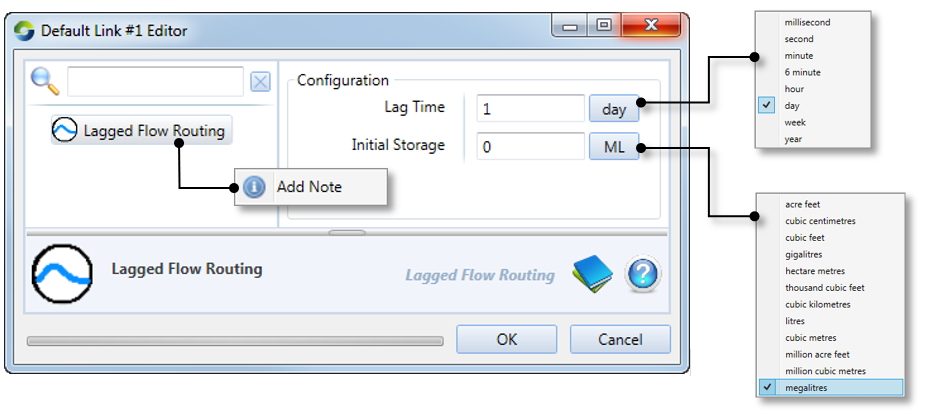Note: This is documentation for version 4.3 of Source. For a different version of Source, select the relevant space by using the Spaces menu in the toolbar above
Link Routing
For an introduction to links, see Nodes and Links.
Types of link routing
Source supports three types of link routing - straight through routing (default), a lagged routing model or a Storage routing model. You are responsible for ensuring that you use the correct model for each link.
Note that you can configure constituents, ownership and ordering for a storage routing link only.
To change the link routing type:
- Right click on the link to display the contextual menu;
- Choose Routing Type; and
- Finally, click on the required link routing.
You can check which routing models are in use in a scenario using the Project Hierarchy. The example in Figure 3 shows that there are two types of links in use - lagged flow and storage routing.
Figure 3. Project Hierarchy (link models)
Straight through routing
All links are assigned straight through routing by default and have the following features:
- Water enters and exits such a link in the same time-step;
- There are no configuration parameters associated with straight through routing links; and
- You cannot configure fluxes, constituents or ownership.
Lagged flow routing
Lagged flow routing only considers the average travel time of water in a river reach. It does not consider flow attenuation. The flow entering a link exits at some whole number of time-steps in the future.
Figure 4 shows the feature editor for a lagged flow routing link and Table 2 lists the associated parameters.
Figure 4. Link (Lagged flow routing)
Table 2. Parameters for lagged flow routing
| Parameter | Type | Definition |
|---|---|---|
| Lag time | Time | This represents the time it takes for water to travel along the link and is a positive real number. If the specified lag time is not an integer multiple of the model time-step, it will be rounded to the nearest time-step. |
| Initial Storage | Volume | The amount of water deemed to be in the link on the first time-step. For example, if there is a lag of two days, and there is 10ML in the link at the start of the run, then 5ML is deemed to be flowing out each day (total initial storage divided by lag). |
Modelling lagged flow routing with storage routing
A link configured for lagged flow routing is treated as a series of sub-reaches or 'divisions' of equal length, with the travel time in each division equal to one time-step. Water moves through the link progressively, without attenuation. You cannot configure fluxes, constituents or ownership on a lagged flow routing link. If lateral flows are significant and/or there is dead storage in the reach, you can model lagged flow routing using storage routing and the generalised non-linear storage option, as follows:
Compute the number of divisions, n, by dividing the average wave passage time by model time-step and round the result to a whole number. The result must be at least one (ie. n ≥ 1);
- Configure a storage flow routing reach where:
- n = number of divisions;
- x = 1;
- m = 1; and
- k = model time-step.
- If you need to account for lateral flows where n = 1 and the average travel time is a fraction of the model time-step (eg. a reach with a one day lag in a model with a monthly time-step), you can adjust k to a smaller value without affecting the shape of the hydrograph.

